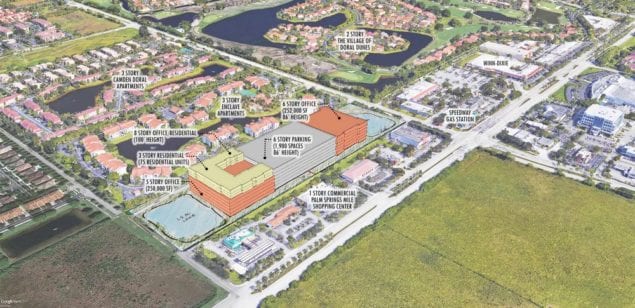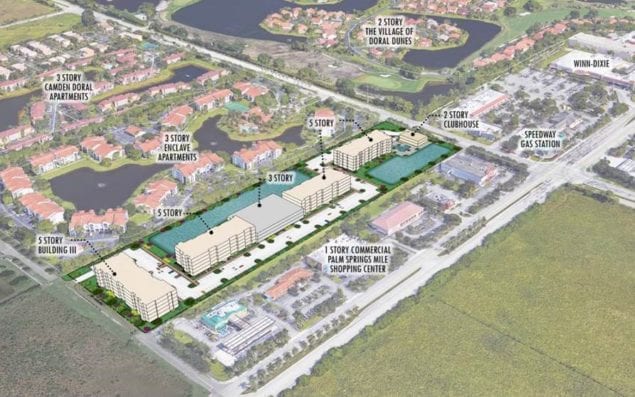The first phase of the Doral 4200 Proposal has been approved. There is still further consultation and voting remaining – and despite some community objections, the project is going forward.
In a May 10 vote by Doral City Council, the rezoning of 10 acres between NW 107th Ave. and NW 109th Ave, on the north side of NW 41st St., was proposed for a development with businesses, offices and about 250 apartments with clubhouse, pool, and 2.5 acres of lakes and walkways among green areas. Doral 4200 would also have a small one-story shopping center.
The project is being developed by CC Residential, affiliated with Codina Partners, a group that has built Downtown Doral and other projects in Miami.
However, there are citizens who oppose the project. For example, Álvaro Ferrando, who promoted a petition on Change.org, gathered 401 virtual signatures. Ferrando states on his Facebook page, “Concerned Citizens of Doral,” that the rezoning was passed “ignoring hundreds of resident signatures.”
In his view, “the consequences of this poor decision” would impact the “quality of life of residents” in everything from traffic to schools. After all Doral 4200 is a “Mixed Use” project that combines all possible sources of human and automotive traffic: residents, workers, buyers, and bystanders.
However, Director of Doral Planning & Zoning Julian Pérez disagrees. He told El Nuevo Herald that these multiple projects – on the contrary – reduce traffic “because they integrate the primary uses of communities and seek a concentration of the population in the same space, which prevents displacement and creates a sense of community. Traffic, one of South Florida’s biggest problems, is due in part to the fact that several of the neighborhoods have been built as ‘bedroom communities,’ residential cities with very little trade in them.”
According to Julián Pérez: “Everybody has to go out in the morning to work and come back at night and that’s what we’re trying to avoid. In the specific case of Doral, mixed uses will allow the city to grow, but at the same time people can work, study, and have fun within minutes of their home.”
Petition on one hand, Doral Community Coalition on the other.
Nonetheless, Álvaro Ferrando continues to promote his request. On May 2, a week before the discussion that changed the zoning, a Doral resident Fernie Franco asked, “Are the people who signed the petition going to show up at the City Hall on May 10? This would send a clear message that people are worried.”
Ferrando did not seem to give it the same importance because, he said, “The petitioners have already signed and expressed their opinion. We will deliver the signatures, comments, and request. In a way, the petitioners will be there.”
However, Alberto Ruiz, President of the Doral Community Coalition (DCC), a non-profit organization that merged the two groups that founded the city (West Dade and One Doral), which advises and counsels the city on the impact of urban projects, has another reading. Ruiz explains that “DCC’s role is to analyze and counterbalance local government. If the project is good we endorse it, if it is not good – as in other cases – we expose it.”
The organization takes into account the impacts of the project on schools, roads, parks – in short, on the flow of people and vehicles. Whatever alters the quality of life of residents.
Alberto Ruiz does not doubt that the project will be approved entirely. He notes, “We analyzed the project for more than six months and DCC decided to support it because it complies with the Zoning and Master Plan of the City; and it is homogeneous and consistent with what is already in the area. The overall project is low density: 800,000 square feet were approved at the May 10 meeting, but only 500,000 will be built. It will be more open, greener, and offer more lakes and corridors to access the shops.”
Codina has announced that this surplus of green areas of approximately 300,000 acres is a voluntary contribution to the reduction of the density of the project and of the zone.
What about traffic, which is the central point of the citizen’s objections? Alberto Ruiz points out, “it will not really impact traffic as much. A residential project has 60 to 80 percent less impact than commercial. During week days, traffic in Doral is impossible, as in any city, but not on weekends. There are no traffic problems from Friday afternoon through Sunday night.” This, according to DCC, happens when there is more traffic in the work week.
Ruiz explains that “if the problem was traffic from its own population, Doral would be like Kendall: congestion 24 hours a day, 7 days a week. In Doral, 120,000 to 150,000 cars enter the city on weekdays, with people who work in the area or use the city as a runner, for example, to move from the Palmetto Expressway to the Turnpike (and vice versa) or to avoid the Turnpike and the Dolphin Expressway tolls.”
In other words, it will not impact traffic because the overflow of vehicles comes from out of town. As Planning Director Julian Pérez explained, communities like Doral 4200 reduce long-term traffic because they increase the number of residents who also work and have fun in the city.
There is one circumstance that Alberto Ruiz points out from the petitioners: “The prosecutors said they had 300 signatures but at the Council meeting not even one showed up to speak up. When Doral Community Coalition makes requests, the supporters express their support or opinions.”
Alberto Ruiz agrees with Councilwoman Claudia Mariaca that this solution is the “least bad,” as she called it, although he prefers to call it “the least impact.”
There are remaining procedures to be carried out, nevertheless, Doral 4200 will be a reality. If reports give a correct diagnosis, communities like these will have not only a low or no impact on traffic, but in the long run will help Doral have a better balance between residences, businesses, and jobs.









I see that everybody complains about not having green spaces. They want everything turned into a park. Who is going to pay for it? Are you going to pay for it? These are private properties and they need to make money out of it? Do you know how much property taxes they pay just to have the land sitting there? I’m a resident since 1999 right off college. I have never liked the separation of businesses, industrial and residential areas in such a way as here in Miami in general. It does not make sense and it does not give you a sense of community. Now if it is a nuclear or chemical plant definitely it has to be separated from other areas. But little warehouses and offices? You want green areas? Buy the warehouses and lands and turn it into your paradise for the benefit of everyone. Now I do understand that there should be more regulations regarding projects and its effects on the community and traffic. And there should be some kind of contribution on the part of the developer to help with the cost of needed infrastructure to alleviate the possible issues. But don’t go out asking for people to give you green areas and pay for it from their pocket.
The problem that existing, particularly long-term residents like me (I’ve been living in Doral for 20 years) is that these developments are being approved with absolutely ZERO infrastructure planning or improvements being made to alleviate the current traffic insanity in this city. I don’t live here only from Friday to Sunday – I live here 7 days a week and it takes 45 minutes to go 1.3 miles between 4:00 pm and 7:00 pm. The gridlock is intolerable and relief from that is what we, the residents, are asking for. When minor roadwork or utility work is done on NW 36th Street and one lane is closed for a few hundred feet during the day, it causes UTTER gridlock that sometimes extends the entire length of the city between the Palmetto and the Turnpike. We need these developers to contribute and pay for infrastructure improvements and relief solutions as a consequence of them bringing even more people into the city. But that never seems to happen in Doral – the last administration of the city is a prime example of how the residents’ quality of life was sold for favors by developers. This just seems to be more of the same. Yes. More green space. But what will CC do to improve the roadways and traffic flow to their center? Every developer wants to be able to drive traffic to their location or else business space will not be leased. That means more traffic, so this notion that mixed use in the middle of urban sprawl without proper infratstrure or mass transit planning if utter nonsense and a fallacy. It’s self-evident now. Lots of development – much of it mixed use. Zero infrastructure investment. Utter gridlock. That is the reality we face and why so many of us are just tired of the same old same old.
Una pena, más construcciones no para El Progreso, sino para lucrar.
Áreas verdes, canchas de futbol, parque con árboles y zona para picnic es lo que hace falta. El central park no es suficiente.
Qué triste que por querer vender y lucrar se pierda esto, que era una vista y pequeño contacto aunque sea visual con la naturaleza.
Podría ser un rancho familiar para la interacción de los niños con animales y naturaleza a la vuelta de la casa, sin necesidad de ir al sur o al norte!
Una pena teniéndolo al lado.